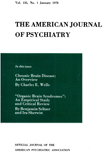THE "DOUBLE BLIND" METHOD: ITS PITFALLS AND FALLACIES
Abstract
A critical review of the so-called "double blind" study reveals pitfalls, fallacies and inadequacies of this method of investigation which in the past has created an unwarranted security in many investigators. The "Worsening" of patients' conditions while on placebos is demoralizing to patients and personnel and the ethics of such a procedure in a patient who is in dire need of active treatment can be questioned. It is imperative that the compound under investigation and the plbcebo have identical appearance and taste, since even disturbed patients, in our experience, are able to differentiate the two drugs by it, thus jeopardizing the most carefully planned and conscientiously carried out project. Side effects occurring on the active compound reveal the identity of the active and inert drug group.
Access content
To read the fulltext, please use one of the options below to sign in or purchase access.- Personal login
- Institutional Login
- Sign in via OpenAthens
- Register for access
-
Please login/register if you wish to pair your device and check access availability.
Not a subscriber?
PsychiatryOnline subscription options offer access to the DSM-5 library, books, journals, CME, and patient resources. This all-in-one virtual library provides psychiatrists and mental health professionals with key resources for diagnosis, treatment, research, and professional development.
Need more help? PsychiatryOnline Customer Service may be reached by emailing [email protected] or by calling 800-368-5777 (in the U.S.) or 703-907-7322 (outside the U.S.).



